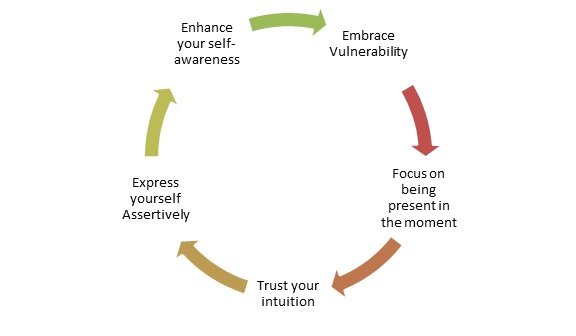The Power of Vulnerability in Building Authenticity

April 26, 2023
"Vulnerability sounds like truth and feels like courage. Truth and courage aren’t always comfortable but they are never weakness." – Brene Brown
When we think about a leader whom we would look upto, we typically imagine a strong figure. They are always focused, professional, and visibly clear in the ideal scenario. However, in this imagery, we often fail to acknowledge that leaders are human too! And like every human, they have their strengths and weaknesses.
In contrast to this traditional conception of a ‘perfect leader’, the new-age leaders are bringing vulnerability back to the workplace. This helps in building a more supportive and trusting workplace environment.
People have the ability to see through a mask or a façade. It is vital for leaders to be authentic to truly build a connection with their teams at the heart level. Leading with vulnerability is often understated, but even more vital than before.
Today, we’ll talk about one of the most important traits for leadership: building authenticity through vulnerability. Let’s take a look! Embracing vulnerability can actually be a powerful tool in building authentic leadership.
But first, let’s understand - What is Vulnerability?
Vulnerability is the act of allowing oneself to be emotionally visible to other. It is also being open to the possibility of emotional pain or rejection. It involves being honest about one’s thoughts and feelings, even if they may not be popular or socially acceptable and express them. For leaders at workplace, it could also mean sharing your weaknesses, struggles and low-points in career. However, it is vital to know what to share, when to share and how much to share to establish a connection with others.
The fastest route to establish a connection with anyone is to be your authentic self. And as Andie MacDowell said “When you are authentic, you create a certain energy, people want to be around you because you are unique.”
So, What is Authenticity?
Authenticity is the quality of being genuine and true to oneself and others. It involves embracing yourself as you are, being honest with yourself and express yourself similarly to others. Authenticity is often associated with a sense of deep self-belief, integrity and sincerity.
It is the biggest asset of a leader – as it is the measure of one’s courage. How can you identify if you are authentic or not?
Start by asking yourself these 3 questions –
- Do I take decisions aligned with my values and beliefs or do I take decisions based on popular consensus?
- Do I communicate my thoughts and feelings exactly how I feel or do I resist from sharing my actual thoughts and feelings?
- Do I take responsibility for my mistakes or do I try to hide them/ justify them?
When you answer these questions, you may/ may not experience a clash of thoughts. If you do, there is scope to improve your levels of self-acceptance that will enhance your authenticity.
How can you use Vulnerability to establish Authenticity?
Vulnerability is important to establish authenticity because it will allow others to connect with you on a deeper level. It will give them the sense, that they know the ‘real’ you. When you are vulnerable, you show your true self, and this can create a sense of trust and understanding with others. Authenticity requires vulnerability because it involves being honest, even if it may not be perfect or socially acceptable.
And how can you become Vulnerable?
Becoming vulnerable can be difficult, especially for those who have been taught to hide their emotions or put up a strong front. However, there are several steps you can take to become more expressive:
Understanding your own emotions and thoughts is the key to become vulnerable and confident. This involves taking the time to reflect on your own feelings and being honest with yourself.
Embrace all emotions you experience - Write them down on a paper and try to identify the best ways to express those emotions to get the desired outcome. For example, if a team member has produced a below average report and you want to ask them to re-work on the same, here’s how to say it;
“Hello Rahul, I read the report you submitted yesterday and wanted to share my feedback. I appreciate the effort you have put in creating the report and I can see the research you have done. I believe, we can make this report even better by working on aspects A, B and C. Adding these to the report will provide a holistic understanding to the client and yield better chances of approval. Let me know if you would require any support from my end.”
Let’s identify what all happened in this situation,
- Instead of being a people pleaser, the leader made a choice to convey what they felt.
- The leader also ensured that his expression of his emotions was ‘assertive’ and at the same time followed a proper ‘feedback mechanism’ focused on constructive areas of growth.
- A win-win situation was created for the leader as well as the team member. The leader authentically expressed what the feeling (here, you could also share a past experience when you may have done a similar report and how you made it better). For the team member, this was a learning experience.
Learn to be Assertive: It is important to express yourself The biggest fear most have while being authentic is – what if I hurt the other person or what if they perceive me Becoming vulnerable does not happen overnight. It is important to start small by opening up to a trusted friend or family member. This can help build confidence and trust in the process.
The "AAMR" framework, and it can be helpful in situations where you need to give feedback or express your needs in a clear and assertive manner. Here's how it works:
- Acknowledge: Begin by acknowledging the other person's perspective or feelings. This shows that you're listening and can help to defuse any defensiveness or resistance.
- Appreciate: Express appreciation for something the other person has done or a positive quality they possess. This can help to build rapport and create a more positive interaction.
- Make a point: Clearly state your point or concern. Be specific and use "I" statements to describe how you feel or what you need.
- Repeat: Repeat your main point or concern, and summarize the conversation to ensure that both parties are on the same page.
Example:
Let's say you needs to give feedback to a team member who has been consistently missing deadlines. You can use the AAMR framework to approach the conversation in a more assertive and constructive manner.
Acknowledge: "I understand that you've been working on multiple projects at the same time and may be feeling overwhelmed."
Appreciate: "I appreciate your hard work and the contributions you've made to the team so far."
Make a point: "However, I'm concerned about the missed deadlines, as it's impacting the overall project timeline and team's ability to deliver on time. I need to see more consistent progress to ensure that we meet our project goals."
Repeat: "So to summarize, while I appreciate your hard work and understand the challenges you're facing, it's important that we work together to ensure that we meet our project deadlines. Can we come up with a plan to address this issue moving forward?"
By using the AAMR framework, you can address the issue in a clear and assertive way, while also acknowledging and appreciating the team member's efforts and perspective. This can help to build trust and promote a more collaborative working relationship.
What is the Framework to be Authentic for Leaders in the Corporate World?
In the corporate world, authenticity is becoming increasingly important as employees and consumers seek transparency and honesty from their leaders.
Here are some key steps leaders can take to be authentic:

Vulnerability is a powerful tool in building authenticity. By embracing vulnerability, you can connect with others on a deeper level and establish trust and understanding. In the corporate world, authenticity is becoming increasingly important as employees and consumers seek transparency and honesty from their leaders. By following the framework outlined above, you can create a culture of authenticity that fosters engagement and productivity among employees.